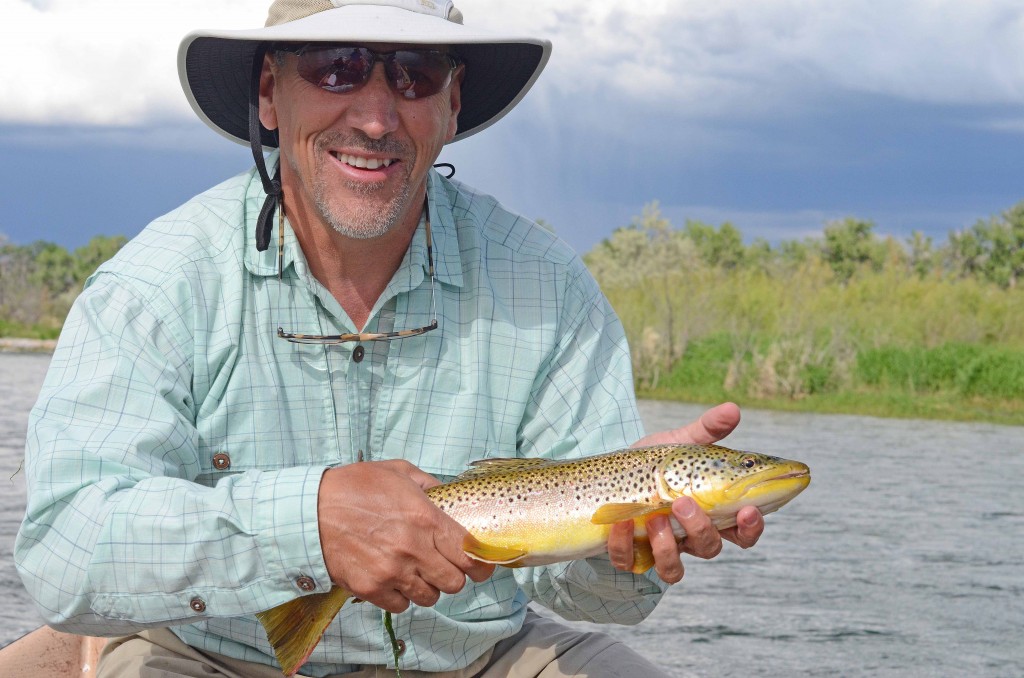Bighorn River Update 8/8/2014
Water flows are low, or maybe I should say normal for this time of year. The black caddis hatch has been the main event for over a month now, but we’ve seen the peak and insect numbers are slowly decreasing. We expect the caddis to continue to provide good dry fly fishing in the afternoon and evening for several more weeks, but be aware that all the hatches are ahead of schedule. If we get far enough ahead of schedule, maybe we’ll begin next year’s hatches. Only kidding. The trico hatch is next on the agenda.
Anglers are still catching large numbers of fish on sowbugs and caddis pupa patterns in the faster water. When water temps warm in late summer and remember, everything is ahead of schedule, the fish move into the faster water where there is more oxygen. They can feed more efficiently in the shallow water as well, because food items are concentrated in a smaller area. Also, aquatic grass becomes a factor as we move towards fall, and a number of slower-water areas become choked with grass.
 Guides continue to do well with the Ray Charles Sowbug and Olive Flashback Pheasant Tails. The boat fishing has been steady in the faster water. I’d push on the oars through the slower stuff. If you’re a decent angler, your best bet is to get out of the boat and work the riffles thoroughly. We’ve been moving the strike indicator down a bit when doing this, five or six feet above the fly is about right. And keep the lead relatively light. Also, you might consider a hopper/dropper rig with about three feet of tippet between the hopper and our nymph. The hopper acts as your strike indicator, but occasionally a nice fish will eat the hopper. Don’t get too excited about this report—yes, you can catch a few fish on hoppers, but it hasn’t been a great hopper year. But if you get out ahead of the boat traffic and fish them hard from the boat, you will take some fish.
Guides continue to do well with the Ray Charles Sowbug and Olive Flashback Pheasant Tails. The boat fishing has been steady in the faster water. I’d push on the oars through the slower stuff. If you’re a decent angler, your best bet is to get out of the boat and work the riffles thoroughly. We’ve been moving the strike indicator down a bit when doing this, five or six feet above the fly is about right. And keep the lead relatively light. Also, you might consider a hopper/dropper rig with about three feet of tippet between the hopper and our nymph. The hopper acts as your strike indicator, but occasionally a nice fish will eat the hopper. Don’t get too excited about this report—yes, you can catch a few fish on hoppers, but it hasn’t been a great hopper year. But if you get out ahead of the boat traffic and fish them hard from the boat, you will take some fish.
The Pseudocloeon mayfly hatch is at full strength. This is a size 22 – 24, pale-olive mayfly that emerges in the afternoon. We still refer to them as “Pseudos,” although the insect has since been lumped into the Baetis genus. I suppose we should refer to them as “Pale Olives” or “Tiny Pale Olives.” These little bugs can provide excellent fishing, but they can create some challenges that frustrate many anglers. Their diminutive size calls for 6X or 7X tippet, and the duns often lie tipped over in the surface film. There are often both duns and spinners on the water, so specific fish will be keyed in on one or the other. These little bugs often hatch at the same time that black caddis are emerging, yet trout often prefer the mayfly. As insurance, you might fish a “black caddis up/mayfly down” setup. From a guiding standpoint, these insects are a pain in the ass—many of our clients don’t have the skills to consistently catch fish when they’re hatching. But if you like a good challenge, don’t ignore them.